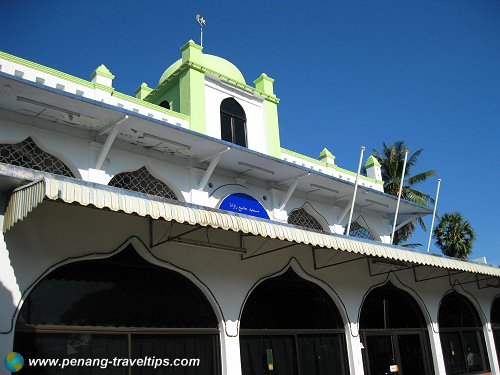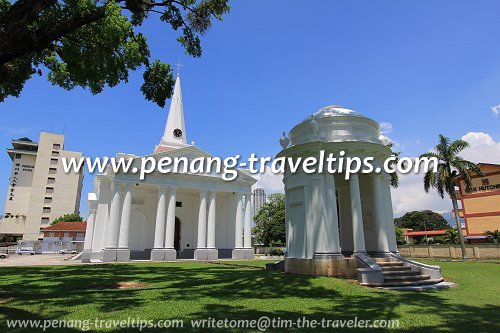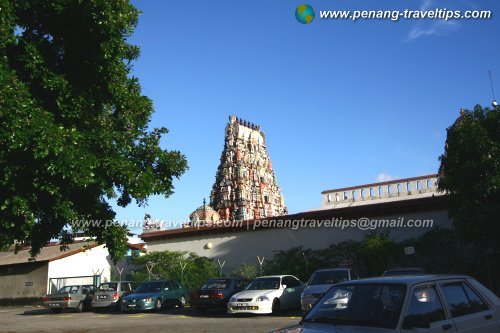Penang Tamils form the majority of Indians in Penang. They trace their ancestry to their homeland in Tamil Nadu (literally "Tamil Country"), today a state in southeastern India.
Many of the Tamils in Penang arrived within a short time after the island was established by Captain Francis Light. However, it is possible that Tamil traders have also already arrived in Penang before Francis Light. Some of them are Hindus and some Tamil Muslims. They inhabited the bank of the Sungai Pinang, living harmoniously with other ethnic groups such as the Sumatrans and Acheenese, along with the Malays.
The Tamil legacy at Sungai Pinang can be seen today in their Hindu temples as well as Indian Muslim mosque, among them the Rawana Jamek Mosque near the Counter Hall intersection.
 Masjid Jamek Rawana entrance arch (15 December 2008)
Masjid Jamek Rawana entrance arch (15 December 2008)
The Tamils have a glorious history. This is reflected in the stylized Temple architecture you can see in the various Hindu temples that they build. Although not much is known about the Tamils outside their own community, their history goes back to the time of the Chola Empire (which gives us the name Chulia also employed to call the Tamils), the Kalinga Kingdom (from which the term "keling" in Malay and "kelinga" in Hokkien trace its origin), and the Pallava Dynasty.
(It should be pointed out that the exact geographical location of the Kalinga Kingdom, now in present-day Odisha and Andhra Pradesh, does not overlap present-day Tamil Nadu. Nevertheless, it has become a generic term used by the locals in Penang to refer to South Indians, as opposed to another term, "Banggali", which is used locally to denote North Indians, including the Sikhs and Punjabis, who are in fact not from anywhere near Bengal.)
 St George's Church was built using convict labourers from Madras (17 April 2011)
St George's Church was built using convict labourers from Madras (17 April 2011)
The Tamils arrived in Penang via various avenues. Many were traders who have been plying the region, not just Penang but the entire Malay archipelago, for centuries. When Penang was established, there was an influx of Tamils, the earliest groups included convicts brought through the port of Madras (now called Chennai) by the British. Fort Cornwallis, in its earlier incarnation, was erected using convict labour. The same is true of other historic buildings built by the British in George Town.
(The British East India Company's rule over the Madras area goes back to 1639, when the British bought a strip of land on the Coromandel Coast from the local ruler, Damarla Venkatadri Nayakudu. By the time Penang was founded, the British was already well established in the Madras area.)
Subsequent waves of Tamil migrants to Penang took on menial labour. They were the earlier water cart bearers and road builders. Indeed, early George Town would not function without the hardworking labourers, many of whom were Tamils.
 Nagarathar Sivan Temple (8 August 2006)
Nagarathar Sivan Temple (8 August 2006)
However, the Tamils are not confined to the labourer class. There were also waves of merchants, particularly the Chettiars, who became the chief money-lenders, not only in Penang but also in Singapore. The term Chettiar may refer to various castes of South Indians. Within Tamil Nadu itself, the Chettiars include the Nagarathar, the Saliya, Senaithalaivar, the Devanga, the Pattariyar, and so on.
Some of the biggest Hindu temples in Penang were financed and supported by the Chettiar group, the most noteworthy being the Nattukkottai Chettiar Temple and the Nagarathar Sivan Temple.
Today the Tamils form an integral part of the rich fabric of communities in Penang, and their festivals continue to be enjoyed by all.

Copyright © 2003-2025 Timothy Tye. All Rights Reserved.

 Go Back
Go Back